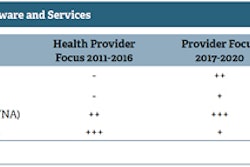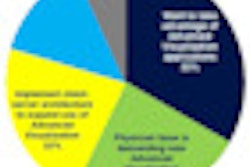Exciting developments are under way in the imaging IT sector, which is benefiting from overall momentum in health IT. The segment has promising growth potential despite an overall slowdown in the medical imaging industry, according to analysis from market research firm Frost & Sullivan.
If the RSNA 2012 meeting is any indication, imaging vendors are continuing to invest a sizeable portion of their R&D dollars into their informatics portfolios. Particularly hot areas are mobile devices and enterprise communication, as well as radiation dose tracking, said Nadim Michel Daher, Frost & Sullivan's principal analyst for medical imaging.
"The reason we think that 2013 might be a hinge year [for imaging informatics] is that [it] has intrinsic drivers of its own right now and doesn't have to depend so much on medical imaging innovation to take the next leap forward," Daher said. "So despite the slowdown we're seeing in medical imaging and despite a lot of the money going away from medical imaging to primary care and other areas, we're still bullish on imaging informatics as a growth segment."
Daher shared his impressions of the RSNA 2012 meeting during a Thursday Frost & Sullivan webinar.
Another slow year?
Overall, this year's RSNA meeting was another slow year for technology innovation in the medical imaging industry as a whole, Daher said.
"The vendors are overwhelmingly worried about the 2.3% medical device excise tax that's going into effect in 2013 and wondering what's it going to mean for innovation, if it's going to be passed on to customers in higher prices and slower innovation," he said.
Reimbursement pressures are also persisting, and procedure volumes are not showing a rapid uptake over the past few years, Daher said. In addition, RSNA attendance was down from last year's meeting. While there were no new major technology breakthroughs at the show, there were considerable advances in current products, however.
For example, Daher pointed to CT, a longtime driver for advances in imaging informatics. Vendors showcased new developments in CT dose reduction, scanner performance, and patient comfort.
The "slice wars" that have characterized the CT market over the past five to 10 years are now definitively over, and there are also more Asia-based competitors, Daher noted. Even from the larger and more expensive brands, new product innovations mainly were seen in the value segment of the market.
Ultrasound and radiography equipment also drew greater attention this year.
PACS update
While much uncertainty remains for imaging innovation, this hasn't seemed to affect imaging informatics activities for PACS vendors, Daher said.
"My general impression is that for the most part, the major PACS vendors have their game together going into 2013," he said. "Over the past two to three years, they have all developed their next-generation PACS, which would be the third generation of these systems if you go back 20 years."
These third-generation PACS, which encompass enterprise imaging, distributed workflow, and intelligent systems, are becoming a market reality, he said.
"We think that the market is on the right track to start adopting more widely these solutions and that PACS replacements are going to take place, even if at a slower rate than historically, going into 2013," he said.
There was less focus this year by vendors on productivity tools, though, and more on business intelligence and analytics.
Meaningful use was less of a buzzword on the show floor this year, which indicates that the radiology community has a much stronger sense as to what can be done and must be done in this area, Daher said.
"It did seem at least from the vendors' messaging that this was less of a hot topic this year," he said.
In archiving, cloud computing is beginning to be well-established for deep archiving, and PACS vendors are also making a concerted effort to do away with the vendor-neutral archive (VNA) terminology in showcasing their enterprise imaging capabilities, he said.
Mobility, enterprise communication
In a change from the past two years, tablets were not shown as gadgets as much in vendor booths.
"There seems to be more maturity in the language of the vendors, instead of saying, 'hey, you can read on a tablet,' whereas everybody knows it's not recommended to do so," he said.
Smartphones and tablet applications are being positioned as the tip of the iceberg for enterprise communication, Daher said. Communication with referring physicians is a hot topic in the radiology community.
"Imaging informatics vendors are overwhelmingly starting to support better communication and giving the means to radiologists to better position themselves with respect to the rest of their enterprise and show more value in their work," he said.
This trend is highlighted by improvements in critical results notification, decision support, and image sharing, according to Daher. Communication with patients is also being explored in line with the RSNA's theme of Patients First for this year's meeting.
"[However], the reality is that radiologists don't see that so much as a priority to engage patients as much as to start communicating better with the other stakeholders that are being brought into the loop of medical imaging going forward, entities such as payors, accountable care organizations that are starting to be developed, and government agencies," Daher said. "There are really high expectations for the PACS vendors to do a better job through mobility and enterprise communication of their systems to really help radiology better position itself."
Despite a slight uptick in RIS replacements, vendors are acknowledging that a lot of the traditional RIS functionality is migrating to the electronic medical record (EMR), he said.
"But that's not to say that the vendors are decreasing their focus on RIS or letting go of workflow," he said. "Not at all. They still feel that workflow is the area where they will be able to add more value. So even if basic RIS functionality migrates to the EMR, there's still a lot to do in enterprise imaging workflow that PACS vendors feel confident they can provide through their IT solutions."
Radiation dose tracking
Daher noted that many vendors were showcasing new radiation dose tracking applications that could be tied to their PACS/imaging equipment.
"PACS is obviously a logical place for such an application, which needs to gather information from several modalities from several departments about any x-ray exams that were performed on a patient," he said.
Dose tracking is rapidly gaining traction in the U.S., not just in states such as California where it's mandated, but in other states as well, Daher said.



















